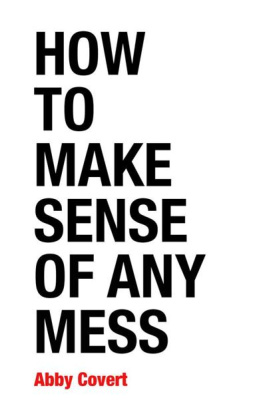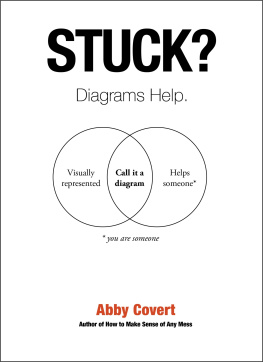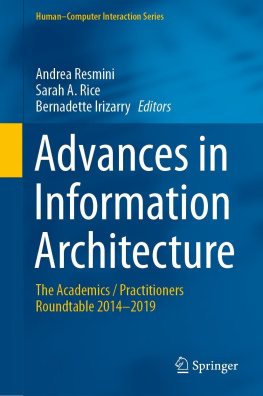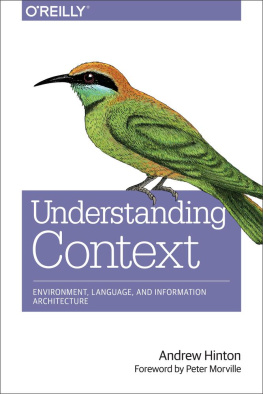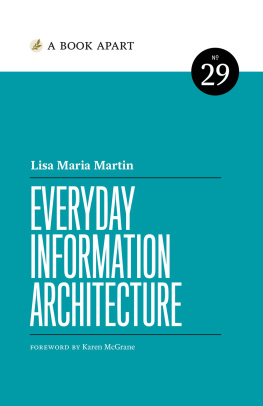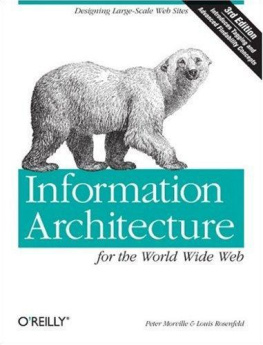To Bill Pink, my grandfather, and the first information architect I ever knew. He taught me how rewarding it is to make sense of a mess.

About
Chapters: This book outlines a step-by-step process for making sense of messes made of information (and people). The steps are in order but most projects are not, so feel free to skip around or jump to a specific term from the lexicon.
Page Breaks: Each time you see a page break in this ebook, a new lesson is beginning. In the print edition, each page was conceived as a lesson in itself. I hope the use of page breaks is a respectful decision for eBook readers. The sequence is how I want to tell the story.
Characters: Each chapter ends with a story about a person who needs to make sense of a mess.
Worksheets: There are worksheets in each chapter to help you to make sense of your own messes. Each worksheet is simple enough to be easily recreated for your own purposes, but I have also provided links to print-ready templates on my website.
Lexicon: In the back of the book, you'll find a lexicon that defines the important terms in the book. The lexicon is also available online.
Written & Illustrated By Abby Covert
Edited By Nicole Fenton
ISBN: 1500615994 ISBN-13: 978-1500615994
Copyright 2014 by Abby Covert All rights reserved.
For more information on this project visit: AbbytheIA.com/makesense 
"If you wish to make an apple pie from scratch, you must first invent the universe." Carl Sagan, Cosmos
Introduction
Think about everything you have to make sense of each day. Projects, products, services, processes, collections, events, performances, boxes, drawers, closets, rooms, lists, plans, instructions, maps, recipes, directions, relationships, conversations, ideas. And the list goes on.
Having to progress in the face of chaos, confusion, and complexity is something we all have in common.
Information architecture is a set of concepts that can help anyone making anything to make sense of messes caused by misinformation, disinformation, not enough, or too much information.
Whether you are a student, teacher, designer, writer, technologist, analyst, business owner, marketer, director, or executive, this book is for you.
In the time that it takes to fly from New York to Chicago, I will introduce you to the practice of information architecture so you can start to make sense of whatever messes come your way.
Table of Contents
1.Identify the Mess
Messes are made of information and people.
A mess is any situation where something is confusing or full of difficulty. We all encounter messes.
Here are some of the many messes we deal with in our everyday lives:
- The structure of teams and organizations
- The processes we undertake in working together
- The ways products and services are represented, sold, and delivered to us
- The ways we communicate with each other

It's hard to shine a light on the messes we face.
It's hard to be the one to say that something is a mess. Like a little kid standing at the edge of a dark room, we can be paralyzed by fear and not even know how to approach the mess.
These are the moments where confusion, procrastination, self-criticism, and frustration keep us from changing the world.
The first step to taming any mess is to shine a light on it so you can outline its edges and depths.
Once you brighten up your workspace, you can guide yourself through the complex journey of making sense of the mess.
I wrote this simple guidebook to help even the least experienced sensemakers tame the messes made of information (and people!) they're sure to encounter.
Information architecture is all around you.
Information architecture is the way that we arrange the parts of something to make it understandable.
Here are some examples of information architecture:
- Alphabetical cross-referencing systems used in a dictionary or encyclopedia
- Links in website navigation
- Sections, labels, and names of things on a restaurant menu
- Categories, labels and tasks used in a software program or application
- The signs that direct travelers in an airport
We rely on information architecture to help us make sense of the world around us.
Things may change; the messes stay the same.

We've been learning how to architect information since the dawn of thought.
Page numbering, alphabetical order, indexes, lexicons, maps, and diagrams are all examples of information architecture achievements that happened well before the information age.
Even now, technology continues to change the things we make and use at a rate we don't understand yet. But when it really comes down to it, there aren't that many causes for confusing information.
- Too much information
- Not enough information
- Not the right information
- Some combination of these (eek!)
People architect information.
It's easy to think about information messes as if they're an alien attack from afar. But they're not.
We made these messes.
When we architect information, we determine the structures we need to communicate our message.
Everything around you was architected by another person. Whether or not they were aware of what they were doing. Whether or not they did a good job. Whether or not they delegated the task to a computer.
Information is a responsibility we all share.
We're no longer on the shore watching the information age approach; we're up to our hips in it.
If we're going to be successful in this new world, we need to see information as a workable material and learn to architect it in a way that gets us to our goals.
Every thing is complex.
Some things are simple. Some things are complicated. Every single thing in the universe is complex.
Complexity is part of the equation. We don't get to choose our way out of it.
Here are three complexities you may encounter:
- A common complexity is lacking a clear direction or agreeing on how to approach something you are working on with others.
- It can be complex to create, change, access, and maintain useful connections between people and systems, but these connections make it possible for us to communicate.
- People perceive what's going on around them in different ways. Differing interpretations can make a mess complex to work through.
Knowledge is complex.
Knowledge is surprisingly subjective.
We knew the earth was flat, until we knew it was not flat. We knew that Pluto was a planet until we knew it was not a planet.
True means without variation, but finding something that doesn't vary feels impossible.
Instead, to establish the truth, we need to confront messes without the fear of unearthing inconsistencies, questions, and opportunities for improvement. We need to be open to the variations of truth that are bound to exist.
Part of that includes agreeing on what things mean. That's our subjective truth. And it takes courage to unravel our conflicts and assumptions to determine what's actually true.
Next page
